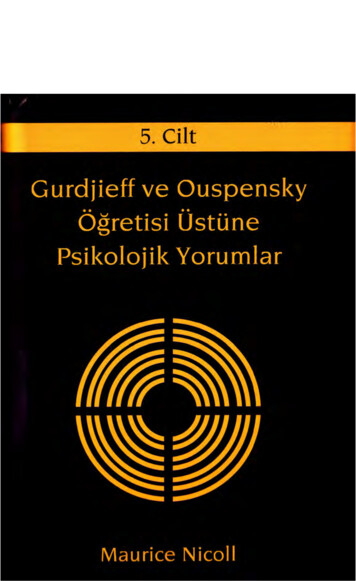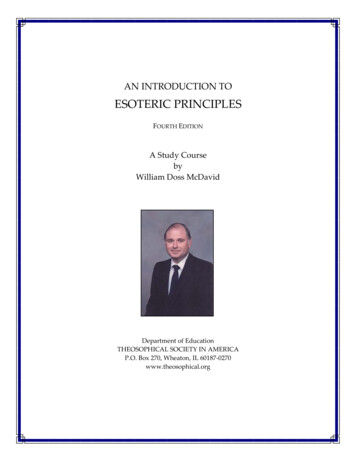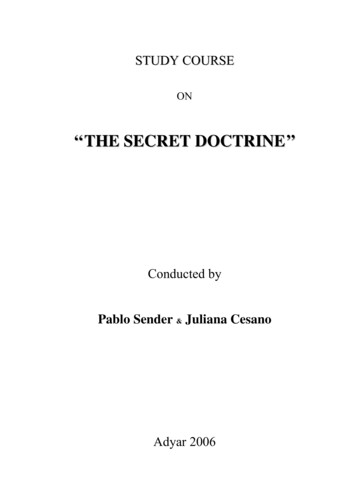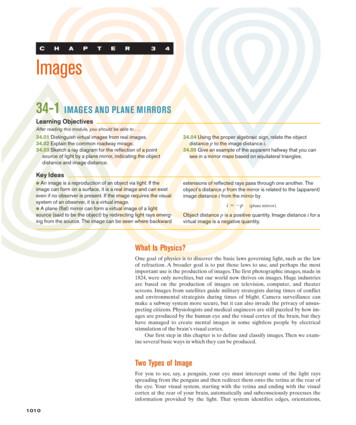
Transcription
GURDJIEFF UNVEILED
GURDJIEFF UNVEILED:AN OVERVIEW AND INTRODUCTION TOGURDJIEFF'S TEACHINGFor the begining student, for the inquiring seeker,and for the simply curiousSeymour B. GinsburgLighthouse WorkbooksGurdjieff related books www.lighthouse-editions.com
First published 2005Lighthouse Workbooksan imprint of Lighthouse Editions LimitedGurdjieff related books www.lighthouse-editions.com 2005 Seymour B. GinsburgThe right of Seymour B. Ginsburg to be identified as the author ofthis work has been asserted by him in accordance with theCopyright, Designs and Patents Act 1988All rights reserved. No part of the book may be reprinted or reproducedor used in any form, or by any electronic, mechanical, or other means,now known or hereafter invented, including photocopying and recording,or in any information storage or retrieval system, withoutpermission in writing from the publishers.British Library Cataloguing-in-Publication DataA catalogue record for this book is available from the British LibraryISBN 1-904998-01-1
Dedicated toNicolas TereshchenkoA serious seeker, a true scholar, a friendSy Ginsburg and Nicolas Tereshchenko, Portland, Maine, March2000.
AcknowledgementsAn earlier book, Gurdjieff: A New Introduction to His Teaching (privately published,1994) served for almost 10 years as the text for an introductory course on Gurdjieff'steaching. Supplies had run out, but a student, Rosemary Hutchinson, who liked thebook very much, asked that it be reprinted again for new students. Although I knewfrom experience with the earlier book that a major revision was needed, it was herurging that finally caused me to undertake this new volume for which she madenumerous suggestions. Other long-time students of Gurdjieff's teaching, JohnAmaral, Dr Keith Buzzell, William Murphey, and Professor Paul Beekman Taylor,were all kind enough to read early drafts. Each of them constructively criticized thetext, making many useful recommendations. Another student, my wife DorothyUsiskin, not only commented on the text but encouraged my effort when encouragement was needed. Many of the comments, suggestions, and recommendations ofthese fellow students have found their way into the text and have undoubtedlyimproved it. However, their help in no way constitutes an endorsement of the text byany of them. In fact, one or more of them disagreed with many of the statements thatappear. Assertions with which a reader may disagree fall entirely on my shoulders.Much of the text and many of the assertions in it reflect the views of my mentor of 19years, Sri Madhava Ashish (née Alexander Phipps, 1920 1997), who is quoted extensively.Lighthouse Editions Limited wishes to thank the publisher, New Paradigm Books(http://www.newpara.com), for permission to reprint associated passages from InSearch of the Unitive Vision: Letters of Sri Madhava Ashish to an AmericanBusinessman, 1978 1997, compiled with a commentary by Seymour B. Ginsburg.Quest magazine (formerly The American Theosophist) has kindly given permission toquote passages from that journal and Triangle Books has likewise given permissionto quote from Gurdjieff’s books Beelzebub's Tales to His Grandson and Views Fromthe Real World.
CONTENTSDedicationAcknowledgementsList of TablesList of DiagramsForeword by Nicholas Goodrick-ClarkePrefacevvixxxixiiiLesson 1: Who am I?a Gurdjieff: a historical noteb. Sleeping humanityc. The verification of new ideasd. Who am I?e. What is the purpose of human life?f. Transferring our identity from personality to essenceg. The Fourth Wayh. Beginning the questi. An exercise in consciousness: putting ourselves in the otherperson's place113468101112Lesson 2: The expansion of consciousnessa. Self-observationb. Expanding consciousnessc. The four states of human consciousnessd. The inner effort required for self-consciousnesse. Attentionf. An experiment in attentiong. Relativity of consciousness in seven different levels of human beingsh. The seven centers (brains)i. Timej. An exercise in consciousness: a "stop" before and during each meal1515151719202123242627Lesson 3: The transmutation of energya. A second experiment in attentionb. The five being-obligolnian strivingsc. Relativity on a larger scaled. The ray of creatione. The law of the three forces (the sacred triamazikamno)29293031323313vii
Gurdjieff Unveiledf.g.h.i.The law of the octave (the sacred heptaparaparshinokh)The enneagramThe human chemical or alchemical factoryAn exercise in consciousness: a "stop" in the doorway35363740Lesson 4: The conservation of energya. A third experiment in attentionb. The importance of energy conservationc. Identificationd. The doctrine of "I"s and the role of "buffers"e. The "man/woman machine" and the terror of the situationf. Lyingg. Unnecessary talkingh. Internal consideringi. Negative and idle (not constructive) imaginationj. Daydreamingk. Identifying with and expressing negative emotionsl. Chief feature: our big buttonm. External consideringn. An exercise in consciousness: internal considering434343444546484949505151525253Lesson 5: Meditationa. First, a look at internal consideringb. The theory of esotericismc. Gurdjieffian meditationd. Preparatione. Quieting the mindf. Preparing myself for meditation (sitting)g. Describing the global body sensing exerciseh. Holding still in preparation for the unitive vision(objective consciousness)i. The unitive visionj. An exercise in consciousness: meditation5555555657596162656769Lesson 6: Gurdjieff groupsa. Am I able to meditate?b. The importance of a groupc. Existing groups and paymentd. Organizing a group1. Weekly meetings2. The recommended text3. Meditatione. The three categories of practical exercises717171737475767777viii
Contentsf. Principal exercises or strivingsg. The reminding and "stop" category of exercisesh. Psychological exercises for observing identificationsi. Gurdjieff musicj. Sacred dance: the Gurdjieff Movementsk. Beelzebub's Tales to His Grandsonl. Toasts to the idiotsm. For whom is the Gurdjieff Work suited?n. How long is the duration of this Work?o. Lovep. ConclusionAppendix 1: Who are you Mister Gurdjieff? A speculative enquiriya. What makes a masterb. Blavatsky and the concept of mastersc. Gurdjieff enters the scened. Writing Beelzebub's Tales to His Grandsone. The Mahatma Letters connectionf. Blavatsky's prediction: an instructor in x 2: Gurdjieff and the study of dreamsa. The importance of accessing the subconsciousb. The development of a dream theoryc. Psychology and the use of dream symbolismd. Seven principles of dream analysise. Techniques for remembering dreamsf. Purificatory dreams and noumenal dreamsg. Noumenal dreams and lucid dreamingh. How much sleep do we need?i. Forming a dream study group9797101103105107108109110111Appendix 3: Exercisesa. A typical weekly exerciseb. Three categories of exercisesc. The principal exercises or strivingsd. Examples of the reminding and "stop" exercisese. The game of stopsf. Examples of psychological exercises in alphabetical orderg. Examples of exercises in page number order fromBeelzebub's Tales to His Grandson113113114115116117118121Appendix 4: Beelzebub's Tales to His Grandsona. Burying the dog deeperb. The perturbations125125127ix
Gurdjieff Unveiledc. The descentsNotesWorks citedIndex127129133135List of TablesTable 1 The four states of human consciousnessTable 2. The ray of creationTable 3 The game of stops1833117List of DiagramsDiagram 1. The enneagramDiagram 2.The enneagram of digestionx3739
ForewordEver since the establishment of his Institute for the Harmonious Development of Mannear Fontainbleau in 1922, the ideas of the Armenian sage George IvanovichGurdjieff (1866? 1949) have continued to attract a dedicated and often distinguishedtrain of followers. Each in their own fashion, his principal pupils, P.D. Ouspensky,A.R. Orage, J.G. Bennett, Maurice Nicoll, and Rodney Collin sought to organize anddevelop Gurdjieff's system, thereby proving its resilience and vigour as a body ofesoteric teachings into the twenty-first century.The Work, the name by which his teachings are most usually known, is drawn fromalchemy, where the Great Work signified the refinement and purification of basemetals into gold as well as the transmutation of the soul into a higher spiritual state.Gurdjieff's teachings similarly aimed at the transformation of man's inner substance.Through cosmological speculations, through lectures, manual work, communal life,and sacred dances or 'Movements' in successive phases of his life, Gurdjieff offereda practical form of esoteric instruction that could harmonize the microcosm of thehuman being with the macrocosm of the universe and so reunite man with theEndlessness or supreme deity.Much has and can be written about Gurdjieff's teachings. Pupils who knew Gurdjieffpersonally typically emphasized his power and charisma, while other followers of theWork have typically emphasized the uniqueness of his esoteric instruction as itimpinged on their own lives. However, these personal and experiential estimates ofGurdjieff's importance have frequently overlooked his status as a major participantwithin a Western esoteric tradition reaching back through the modern occult revivalto the Renaissance and thence to Hellenistic antiquity.As Seymour Ginsburg relates in his preface, his introduction to Gurdjieff coincidedwith an understanding of esotericism as a form of teaching intended to expand humanconsciousness for the purposes of discovering who we are, what is our purpose, andwhat is the nature of reality. As in the famous words of the Emerald Tablet of HermesTrismegistus "As above, so below", esoteric philosophy always seeks to link themicrocosm with the macrocosm through a system of correspondences, hierarchies,and intermediaries. The resultant interaction of cosmology and anthropology leads toa meaningful location of man in the universe and the transmutation of the humansoul through the understanding of identity, significance and purpose.xi
Gurdjieff UnveiledThis book is a remarkable distillation of Gurdjieff's teachings within that wider awareness of Western esotericism. Following Gurdjieff's own techniques, the book is firstand foremost a practical guide, beginning with the fundamental proposition that humansmust be awakened to self-awareness, to the realisation that behind our "personality",influenced by any number of circumstances, lies our "essence", which is our identitywith the universal. The teaching is thus not about attainment of something that ismissing, so much as the discovery or awareness of our real identity. AlongsideGurdjieff''s teachings relating to the transmutation of energy within the context of hiscomplex cosmology, Ginsburg provides stepped lessons in the raising of one'sconsciousness, with techniques for increasing attentiveness and the conservation ofour intellectual and spiritual energies. Other chapters address the practice ofmeditation and recommendations for organizing a Gurdjieff group, involving music,sacred dance, and readings from Beelzebub's Tales to His Grandson.While the principal thrust of this guide is practical esotericism, an interesting appendixthrows important light on Gurdjieff's own debt to Western esotericism. The sourcesof his teachings long remained obscure, supposedly drawn from the mingled influencesof Eastern Christianity and Sufism in the multicultural patchwork of the Caucasusand Central Asia. However, Ginsburg also traces Gurdjieff's inspiration to the modernoccult revival, in particular to the work of Helena Petrovna Blavatsky (1831 1891),the founder of modern Theosophy. Blavatsky's major work The Secret Doctrine (1888)comprised two volumes devoted respectively to cosmogenesis and anthropogenesis.She claimed that the work was at least partly inspired by her two teachers or mahatmas,masters of wisdom resident at a secret centre in Tibet. Blavatsky promised morepractical teaching in a later volume and also hinted at the advent of another teacherto be sent by the masters of wisdom. As Ginsburg shows, Gurdjieff had high-levelcontacts in the Theosophical Society, including two editors involved in the publicationof the Mahatma Letters. Ginsburg's suggestions of Gurdjieff's debt to Theosophy areamply confirmed by the recent research of Sophia Wellbeloved into the numerologicalparallels between their cosmologies.Thanks to the pioneering work of Professor Antoine Faivre at the Sorbonne, theWestern esoteric spirituality is at last finding recognition as a coherent subject ofacademic study. Whether or not Gurdjieff's teaching can be regarded as the fulfilmentof Blavatsky's prophecy, his system for the transformation of consciousness representsa major example of applied Western esotericism. Ginsburg's concise and masterly studyserves as an ideal introductory guide to its practice and provenance. It will be of interestboth to practitioners and students who wish to understand Gurdjieff in a wider context.Dr Nicholas Goodrick-ClarkeDirector, Centre for Western EsotericismUniversity of Wales Lampeterxii
PrefaceGurdjieff Unveiled is a new overview of and introduction to the teaching of G.I.Gurdjieff. In 1994, an earlier book entitled Gurdjieff: A New Introduction to HisTeaching was privately printed. It arose as the result of my collaboration with NicolasTereshchenko.Nicolas and I met in 1982 because of an article on Gurdjieff's teaching that he hadwritten for an alchemical journal I happened to chance upon. We became friends andI learned that Nicolas had come in touch with the teaching in 1957. He was for manyyears in Jeanne de Salzmann's group of senior students at the Institut Gurdjieff inParis. Jeanne de Salzmann was Gurdjieff's closest confidant during the last half ofhis life, and the principal exponent of his work from his passing in 1949 to her deathin 1990.Over the years as our friendship grew, I discovered that Nicolas Tereshchenko wasat the t
A.R. Orage, J.G. Bennett, Maurice Nicoll, and Rodney Collin sought to organize and develop Gurdjieff's system, thereby proving its resilience and vigour as a body of esoteric teachings into the twenty-first century. The Work, the name by which his teachings are most usually known, is drawn from alchemy, where the Great Work signified the refinement and purification of base metals into gold as .











